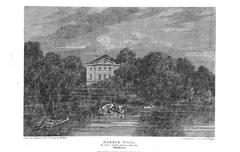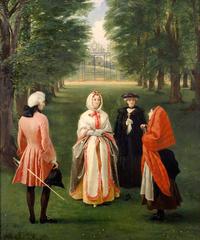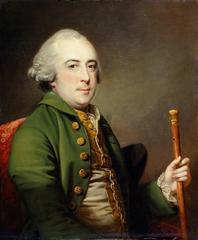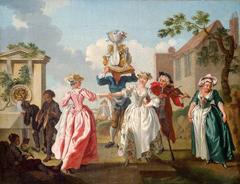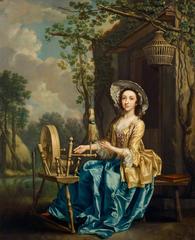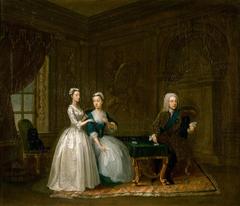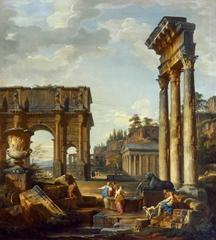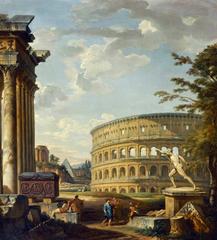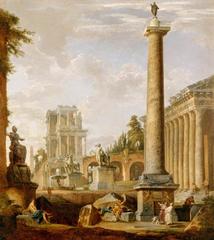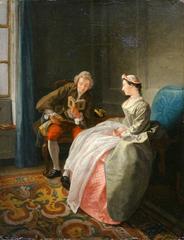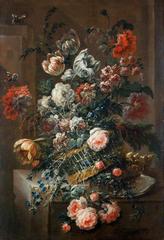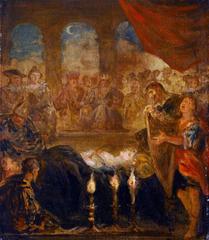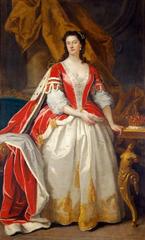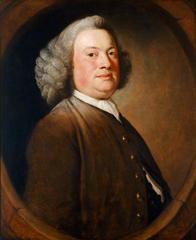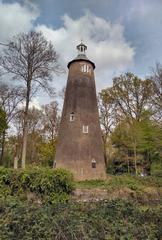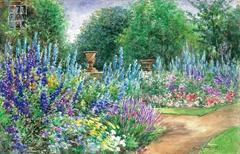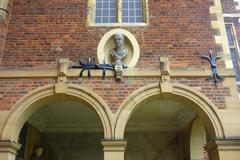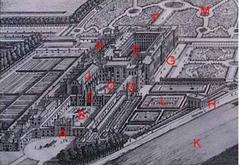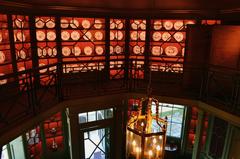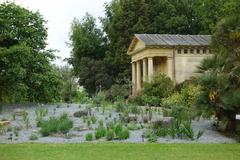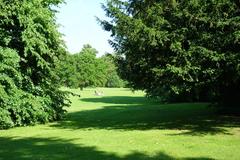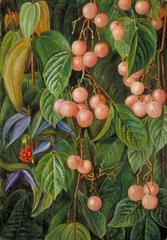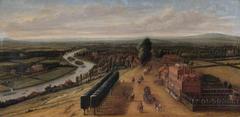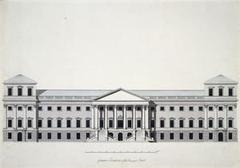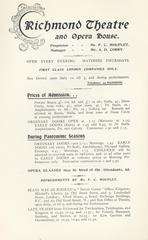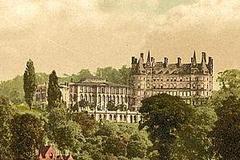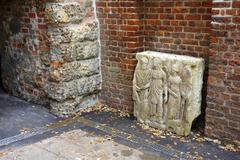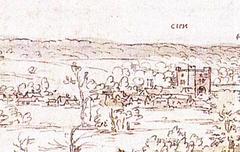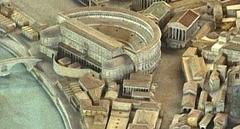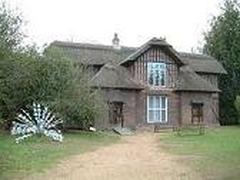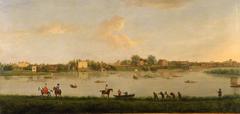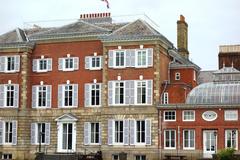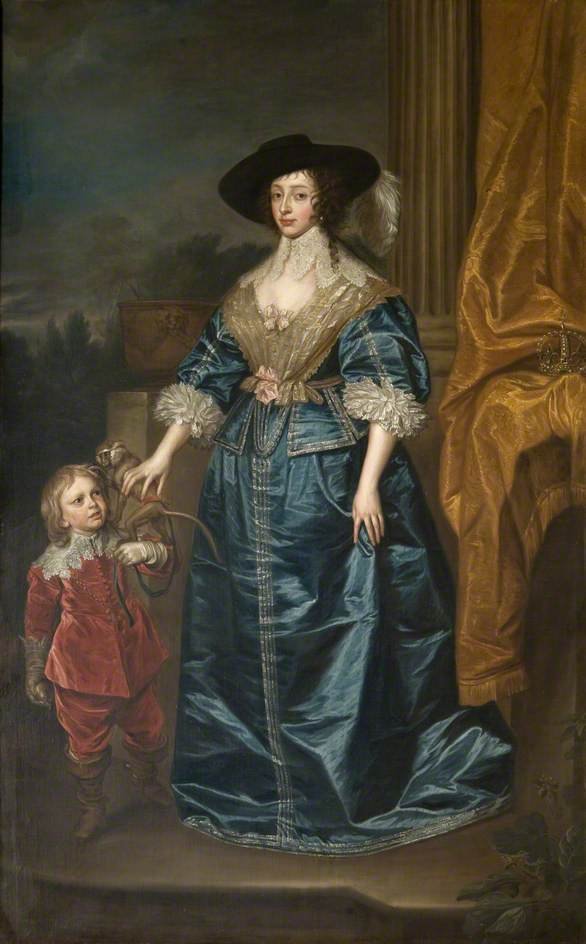
Marble Hill House: Visiting Hours, Tickets, and Richmond Historical Sites Guide
Date: 14/06/2025
Introduction
Marble Hill House, gracefully positioned on the banks of the River Thames in Richmond, is a premier example of early 18th-century Palladian architecture and a vital piece of Georgian social history. Commissioned by Henrietta Howard, Countess of Suffolk and confidante to King George II, the villa exemplifies the era’s architectural elegance and became a gathering place for literary and political luminaries. Today, Marble Hill House is maintained by English Heritage, following a meticulous restoration that revived both its interiors and extensive parkland. This guide brings together everything you need to plan a visit, from opening hours and ticketing to accessibility, travel guidance, and nearby attractions, ensuring an enriching experience at one of Richmond’s most iconic landmarks (English Heritage; Museum of London; ianVisits).
Table of Contents
- Introduction
- Historical Overview
- Visiting Marble Hill House: Essential Information
- What to See and Do
- Nearby Richmond Historical Sites
- FAQs
- Conclusion and Planning Tips
- References
Historical Overview
Origins and Construction (1724–1729)
Marble Hill House was built between 1724 and 1729 for Henrietta Howard, Countess of Suffolk, as a riverside villa exemplifying the Palladian style (English Heritage). Designed by Roger Morris with input from Henry Herbert, 9th Earl of Pembroke, the house drew inspiration from Andrea Palladio’s Italian villas, particularly the Villa Cornaro. The harmonious proportions and classical detailing set a new standard for English country houses and influenced American architecture, including Thomas Jefferson’s Monticello (Wikipedia; Londontopia).
Henrietta Howard and Her Social Circle
Henrietta Howard (1689–1767) was a notable figure at the Georgian court, admired for her intellect and resilience. After overcoming personal adversity, she established Marble Hill as her residence and a sophisticated salon for leading thinkers, poets, and politicians, including Alexander Pope and Horace Walpole (English Heritage). The villa’s gardens, shaped by Howard’s vision and the influence of Charles Bridgeman, exemplified early landscape garden design.
Architectural Influence and the Arcadian Thames
Marble Hill House played a key role in shaping the “Arcadian Thames”—an area along the river known for elegant villas and landscaped gardens. Its Palladian design, particularly the cubic saloon and proportional symmetry, inspired numerous smaller country houses and contributed to a lasting architectural legacy in Britain and the American colonies (Londontopia; Wikipedia).
Later Ownership, Decline, and Preservation
After Henrietta’s death, Marble Hill House changed hands several times, housing figures like Mrs. Fitzherbert (secret wife to George IV). By the late 19th century, the building and grounds faced decline and threats of redevelopment. Public outcry led to the Richmond, Ham and Petersham Open Spaces Act 1902, safeguarding the estate and the iconic view from Richmond Hill (English Heritage; Richmond Local History). The London County Council purchased the property and opened it to the public in 1903, making it the first 18th-century house in England preserved by a public authority.
Modern Restoration
English Heritage assumed management in 1986 and led an extensive restoration funded by the Heritage Lottery Fund in the 2020s. This project restored period-accurate interiors, recreated historical gardens, and enhanced accessibility—ensuring Marble Hill House remains a vibrant and educational destination (Wikipedia; MummyTravels).
Visiting Marble Hill House: Essential Information
Opening Hours (2025)
- April to November: Wednesday to Sunday, 10:00 am – 5:00 pm (last entry 30 minutes before closing)
- November to March: By pre-booked appointment only
- Bank Holidays: Generally open, following standard Sunday hours
Always verify opening times on the official English Heritage website.
Ticketing and Booking
- Entry: Free admission as of 2025 (House & Garden)
- Special Events/Tours: Some activities may require a ticket or advance reservation—consult the official website for details.
Accessibility
- House: Step-free access to most main rooms on the ground floor; accessible toilets available.
- Upper Floors: As of June 2025, the lift is out of service—upper floors accessible by stairs only (English Heritage).
- Park: Level paths suitable for wheelchairs and mobility aids.
- Assistance: Staff are available to help; assistance dogs welcome.
Directions and Travel Tips
- Address: Marble Hill House, Richmond Road, Twickenham, London, TW1 2NL
- By Train: St Margarets (15-minute walk), Twickenham (25-minute walk)
- By Tube: Richmond Station (District Line/Overground, 25-minute walk)
- By Bus: Routes 33, 490, R68, R70—stop at Marble Hill Park/Crown Road (London Luminaries)
- By Car: Paid car park via Richmond Road; disabled drop-off by prior arrangement
Facilities
- Café with refreshments and light meals
- Gift shop
- Toilets and baby changing
- Picnic lawns and children’s play area
Special Events and Tours
Marble Hill House hosts family-friendly activities, themed workshops, seasonal events, and guided tours. Audio guides are often available. Check the English Heritage events calendar for current offerings.
What to See and Do
Explore the Villa
- State Rooms: Restored to original Georgian color schemes with period furnishings and art
- Great Room: Features a perfect cubic design and capricci paintings by Giovanni Paolo Pannini
- Interpretive Exhibits: Learn about Henrietta Howard’s life, her influential social circle, and the estate’s legacy
Gardens and Parkland
- 66 Acres: Blend of formal avenues, woodland, riverside walks, and open lawns (Museum of London)
- Restored Features: 18th-century arcade, nine-pin bowling alley, orchard, and flower gardens
- Picnicking: Riversides and lawns designed for scenic relaxation
Family and Educational Activities
- Workshops, trails, and interactive exhibits for all ages
- Educational beehive and ecology installations (MummyTravels)
Photo Opportunities
- Suggested Spots: The villa’s north and south facades, the cubic Great Room, gallery windows with park views, and restored gardens
Nearby Richmond Historical Sites
Enhance your visit with these local attractions:
- Strawberry Hill House & Garden
- Orleans House Gallery
- Ham House & Garden
- Turner’s House
- Kew Palace
All are easily accessible and offer further insights into the area’s rich heritage (London Luminaries; Visit Richmond).
Frequently Asked Questions (FAQs)
Q: What are Marble Hill House’s visiting hours?
A: Wednesday to Sunday, 10:00 am – 5:00 pm (April–November); pre-booked appointments only (November–March). Always check the official website for updates.
Q: Is entry free?
A: Yes, general admission is free; charges may apply for special events or guided tours.
Q: Is the site accessible for wheelchair users?
A: The park and ground floor are accessible. As of June 2025, the house’s lift is out of service; upper floors are only accessible by stairs.
Q: Are guided tours available?
A: Yes, regular guided tours and special event tours can be booked via the English Heritage website.
Q: Can I bring my family?
A: Absolutely. The estate is family-friendly with open spaces and seasonal activities.
Q: Are dogs allowed?
A: Dogs are welcome in the parkland but not inside the house.
Conclusion and Planning Tips
Marble Hill House stands as a beacon of Georgian architecture, social history, and landscape design. With free admission, accessible grounds, and a lively calendar of events, it appeals to everyone from history enthusiasts to families looking for a scenic day out. Its proximity to other heritage sites makes it a perfect starting point for a comprehensive exploration of Richmond’s cultural landscape.
Plan your visit:
- Review current opening hours and special events on the English Heritage website.
- Consider combining your trip with a tour of nearby historic houses.
- Download the Audiala app for audio tours and visitor tips.
- Follow social media for the latest updates and seasonal programs.
Experience the elegance and history of Marble Hill House—a Georgian masterpiece preserved for the enjoyment and inspiration of generations.
References and Further Reading
- English Heritage – Marble Hill House
- Wikipedia – Marble Hill House
- Londontopia – Great London Buildings: Marble Hill House
- Museum of London – Marble Hill House
- ianVisits – Marble Hill House Reopening
- Richmond Council – Marble Hill House & Park
- London Luminaries – Marble Hill House & Park
- House & Garden – Marble Hill
- MummyTravels – Marble Hill House with Kids
- Visit Richmond
- Lonely Planet


